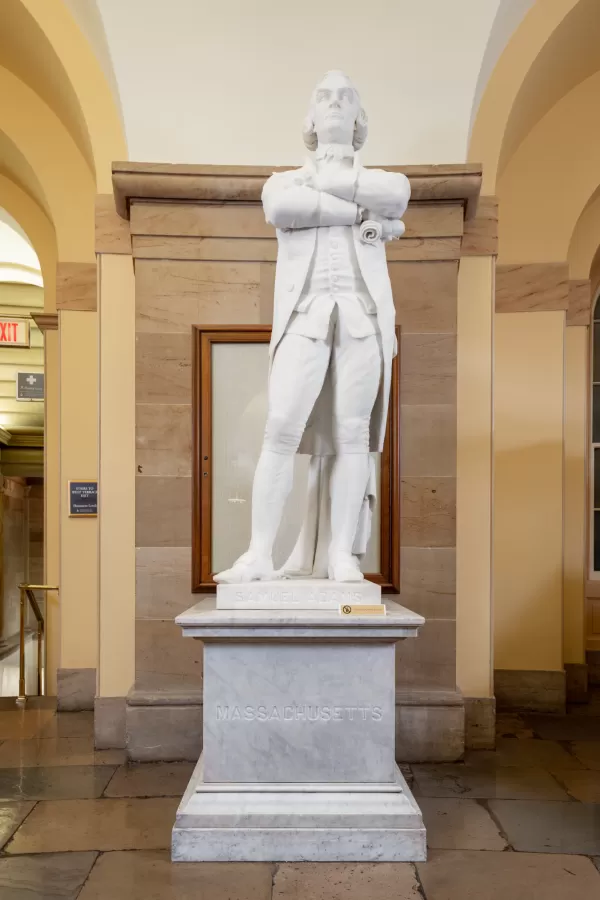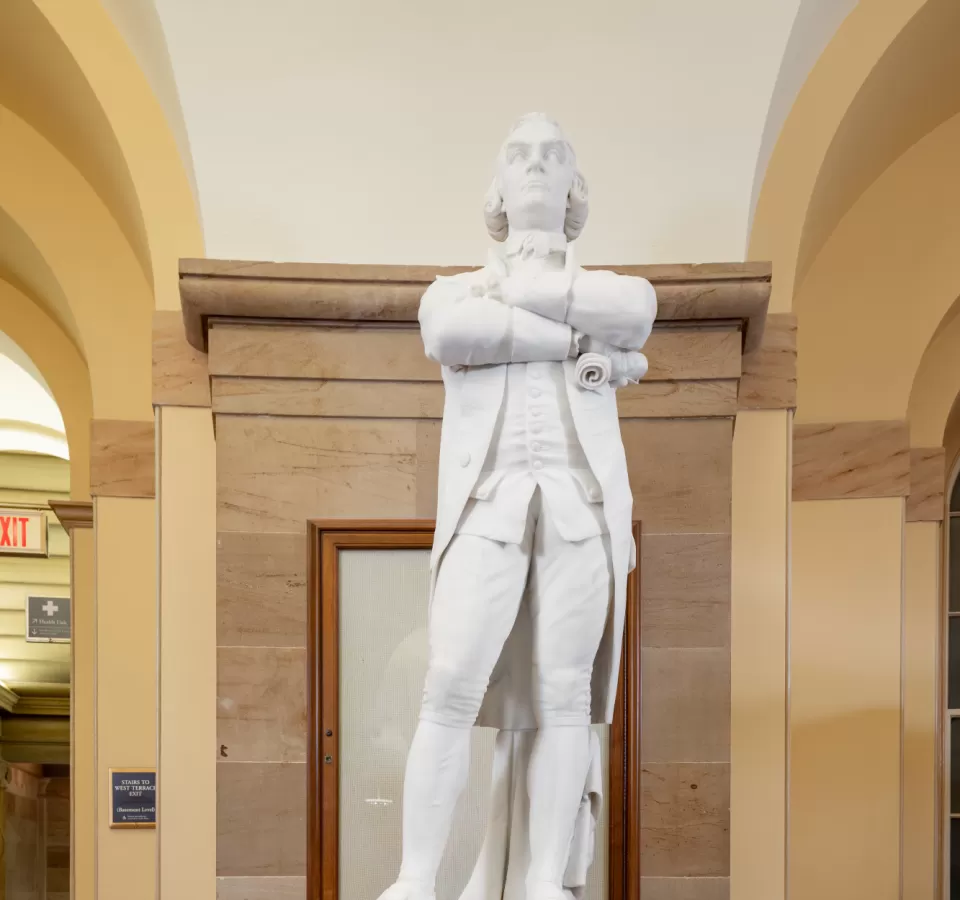Massachusetts gave this statue to the National Statuary Hall Collection in 1876. Sculptor Anne Whitney (1821-1915) was the second woman to complete a full-length statue for the Capitol and the first to have one included in the collection.
Whitney portrays Adams in early middle age, standing erect with arms folded and feet apart, his weight settled over his left leg. The toe of his right shoe projects slightly beyond the self-base. He looks straight ahead, his face set in an attitude of defiant determination. Adams frequently challenged local representatives of British authority, including Massachusetts Governor Thomas Hutchinson and military leaders. Anne Whitney’s portrait of Adams depicts one such moment during the opposition to the Townshend Acts. In 1770, British troops quartered in the city killed five Bostonians in the "Boston Massacre." Adams led a delegation to confront Hutchinson and the regimental commanders with a demand to remove all the troops from Boston. Adams noted that restless colonists were gathering in and near the city and then uttered the words carved on the right side of the statue’s base: "Night is approaching. An immediate answer is expected. Both regiments or none."
He grips a roll of papers in his right hand—records do not indicate whether Whitney intended these to represent specific documents—evoking the tension of the moment before the royal representatives agreed to remove the troops. Stories like these led the Massachusetts legislature to select Samuel Adams as a "fitting representative" of the "revolutionary period" in May 1872.1 Other elements of Adams's biography contributed to this impression of his representative stature. Born in Boston to parents who instilled Puritan values of personal and civic responsibility, Adams entered Harvard at the age of 14 and received his degree in 1740; he completed a master's degree in 1743. At Harvard, he was profoundly affected by John Locke's doctrine that every citizen is endowed with natural rights to life, liberty and property, and argued in his master's thesis that it was "lawful to resist the supreme magistrate, if the commonwealth cannot be otherwise preserved."2
Whitney's realistic approach to her subject pays close attention to the details, including the wrinkles, of his colonial-era dress: high-collared shirt, knee-length coat, waistcoat, breeches, stockings and buckled shoes. The posture and details generate life and vitality in a monumental figure, similar to the active role Adams played in local colonial government, both officially and through private clubs that influenced the town meeting's decisions. His talents lay in politics and persuasion rather than in commerce or personal finance. Adams often composed the Boston meeting's communications to the colonial legislature, and he made a point of advocating with influential Bostonians for natural rights and lawful resistance to Britain.
As relations with Britain deteriorated, Adams co-founded the Sons of Liberty and led Boston's resistance to British attempts to tax colonists. In 1772 he was one of the leading forces behind the Non-Importation Association and the Boston Tea Party. He initiated the Massachusetts committee of correspondence, which connected Massachusetts towns with one another and with other colonies, and he drafted the Boston declaration of rights. During less contentious periods, he wrote numerous newspaper articles under a variety of pseudonyms and kept political theories of freedom present in public awareness. The words incised on the outside of the scroll reference these activities: "Petition of Boston to British."
Adams served in Massachusetts colonial and state governance positions. He represented Massachusetts at the Continental Congress from 1774 to 1781, where he voted for and signed the Declaration of Independence and was a member of the Board of War. Later, as a delegate at the Massachusetts ratifying convention, he initially opposed the new U.S. Constitution because he feared it centralized too much power in the federal government. However, he voted to support it once proposed amendments were added to the ratification.
The statue stands on a simple marble pedestal, with a total height of more than 10 and half feet. The pedestal inscriptions include "SAMUEL ADAMS/MASSACHUSETTS" on the front and "PRESENTED BY MASSACHUSETTS, 1876" on the proper right. The proper left side of the pedestal contains the quote discussed above and the date Adams uttered it, March 6, 1770.
On December 19, 1876, each house of Congress passed the resolution to accept the statues of Adams and John Winthrop from Massachusetts. Members of the Massachusetts delegation and two additional Members lauded the two men, discussed American history, and reviewed political theory. Several speakers commented that it was especially appropriate for the Adams statue to arrive during the centennial year of the signing of the Declaration of Independence. The statue was displayed in National Statuary Hall until 1976, when it was moved to the East Central Hall along with other statues from the first thirteen states. In 2003, statues in the East Front were relocated due to construction of the Capitol Visitor Center; the Adams statue was placed in the Crypt, where it remains today.
Artist
Anne Whitney, born on September 2, 1821 in Watertown, Massachusetts, began sculpting in her 30s. She was already well-known in New England as a poet and activist for abolition and women's rights, but made sculpting her career.
Most nineteenth-century American art schools prohibited women's full participation in classes, but Whitney took courses at the Pennsylvania Academy of the Fine Arts and studied anatomy in Boston and New York. She traveled to Europe, where women faced fewer barriers in the art world, to study and sculpt; she was one of a group of American female artists living in Rome. Her early work reflected the neoclassicism then dominant in sculpture, but Whitney soon began to include more realistic or naturalistic elements.
One of three artists invited to compete for the Samuel Adams commission, she was selected in 1873. After she won another competition and then lost the commission because she was a woman, Whitney refused to enter new competitions. She continued sculpting, however; she accepted commissions and exhibited pieces, including at the World's Columbian Exposition. Her choices of subject, such as Harriet Beecher Stowe and William Lloyd Garrison, often demonstrated her continuing interest in progressive causes and politics. She lived in Boston and New Hampshire until her death at age 93 on January 23, 1915 in Boston.
Whitney completed the model of the Adams statue and then returned to Italy, as the commission required, to oversee the plaster model's carving in Carrara marble in 1875. The Boston Athenaeum displayed the completed statue in July 1876; then it was shipped to the U.S. Capitol and officially accepted in December. Whitney became the second woman to have a full-length statue accepted for the Capitol's collections, and she was the first woman to contribute a statue to the National Statuary Hall Collection. In 1880, the city of Boston requested a bronze copy of the statue to place near Faneuil Hall.
1. Chapter 64 of the Resolves of 1872, 93rd General Court, approved May 6, 1872, 356
2. Quoted by Sen. Henry Laurens Dawes, remarks on presentation of Massachusetts statues, on December 19, 1876, 44th Congress, 2nd session, Congressional Record 5, pt. 1:281.
Podcast Episode: Anne Whitney And The "Marmorean Flock"
This podcast is part of the Shaping History: Women in Capitol Art series created by the U.S. Capitol Visitor Center. Listen below to hear about the women artists and women historical figures depicted in the art of the Capitol.

